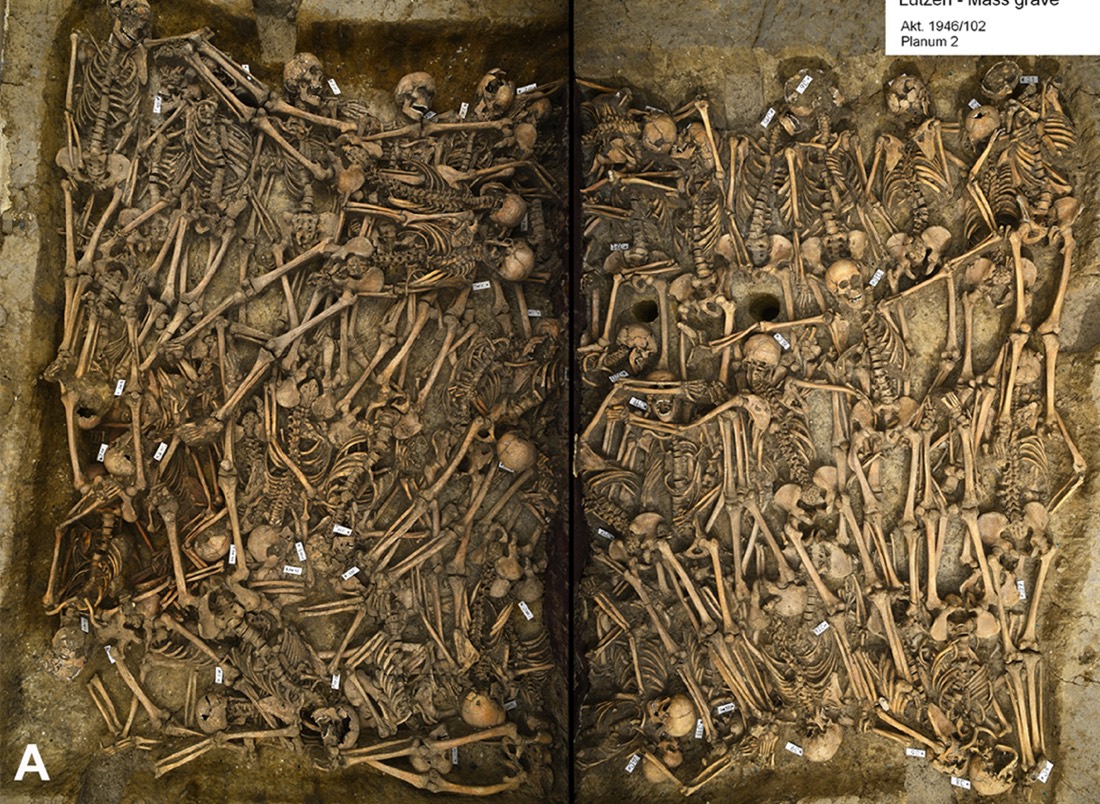Mass Grave from Thirty Years' War Battle Reveals Soldiers' Fatal Wounds

In November of 1632, the townspeople of Lützen, Germany, were stuck with a grim task: They had to bury some 9,000 soldiers who were left dead on a battlefield after a bloody fight during the Thirty Years' War.
Archaeologists recently undid some of that work.
A few years ago, researchers uncovered a mass grave at the site of the Battle of Lützen.By analyzing the bones, they have now learned more about the violent lives and deaths of soldiers from this era. [See Images of the War Grave and Battle Injuries]
The Thirty Years' War was one of the bloodiest events in European history — deadlier than the Black Death and World War II, in terms of the proportion of the population lost. Fought between 1618 and 1648, the conflict started out as a struggle between Catholics and Protestants within the Holy Roman Empire. The brutal clashes touched much of central Europe, but most of the battles were fought in what is Germany today.
Outside of the killing on the battlefields, famine and disease outbreaks devastated populations. Both sides in the conflict heavily relied on wealth-seeking foreign mercenaries (whose loyalties might change based on who was paying more), and occupying armies terrorized civilians in cities and villages.
One turning point in the war came when Sweden intervened in 1630, lending support to Protestant forces. Swedish King Gustav II Adolf led a series of victorious battles, until he was killed in a fight against General Albrecht von Wallenstein, commander of the Holy Roman Empire's imperial troops, during the Battle of Lützen, just southwest of Leipzig, on Nov. 16, 1632.
Wounds of war
Archaeologists located the site of the Battle of Lützen in 2006 after a metal-detector survey turned up about 3,000 projectiles, ammunitions and other objects from the fight. A trench excavated in 2011 then revealed a mass grave. To prevent the burial site from being looted by treasure hunters and eroded by bad weather, the scientists didn't excavate the skeletons on the site. Instead, they lifted the remains out of the ground in a 55-ton block of soil, split into two.
Get the world’s most fascinating discoveries delivered straight to your inbox.
Led by Nicole Nicklisch, of the State Office for Heritage Management and Archaeology Saxony-Anhalt, a team of bioarchaeologists analyzed the 47 skeletons in this block of dirt, looking for the fatal injuries the men sustained during the battle.
According to their results, published in the journal PLOS ONE on May 22, most of the men were already in rough shape when they headed into their final battle. Sixteen had experienced previous head injuries; one man had even suffered four head wounds in previous conflicts before he died. Twenty-one had other healed or healing bone injuries, like fractures in the arms, legs and ribs.
By looking at the unhealed wounds, the researchers could see what the men suffered on the battlefield. Though some men had cut marks and slash wounds on their bones, bladed weapons seemed to play a minor role in the deaths of these soldiers. Instead, more than half of the men had been hit by gunfire. Twenty-one suffered gunshot wounds to the head, and 11 of them had bullets still lodged in their skulls.
Cavalry attack
The high number of gunshot wounds was unusual for the time — at least compared to other mass graves from the Thirty Years' War found German sites like Wittstock and Alerheim. Swords and knives were still "the weapons of choice for hand-to-hand combat," the researchers wrote. [Photos: Mass Graves Hold 17th-Century Prisoners of War]
This unusual gunfight at Lützen might match one account of the battle. Historical records suggest that an elite unit (mostly made up of hired German soldiers) of the Swedish army called the Blue Brigadesuffered a deadly defeat in the area where the grave was found, after they were attacked by surprise by a cavalry unit from the Catholic imperial army, the researchers said.
Remains of bullets reveal that the soldiers had been attacked with pistols, muskets and carbines—weapons that cavalrymen used for short distances. Historical records mention that soldiers would keep bullets in their mouths so they could quickly reload their guns during battle, and two of the skeletons in the grave still had unfired lead bullets in their oral cavity.
The researchers speculate that most of the men buried in this grave were fighting for the Swedish army, though it's likely soldiers for the imperial Catholic army ended up in the pit, too. There was not much clothing or material found with the bodies, suggesting that the soldiers were stripped of their uniforms and whatever else they were carrying before they were buried. And while some bodies seem to have been laid down with care, others appear to have been thrown into the pit, most likely by the townspeople who were left to clean up the mess a few days after the battle, after the armies had moved on.
"It can certainly be assumed that the local population of Lützen did not have a positive attitude towards the fallen soldiers, regardless of any military affiliation," the researchers wrote. "In the Thirty Years' War, every battle brought destruction and deprivation for the rural population."
Original article on Live Science.



